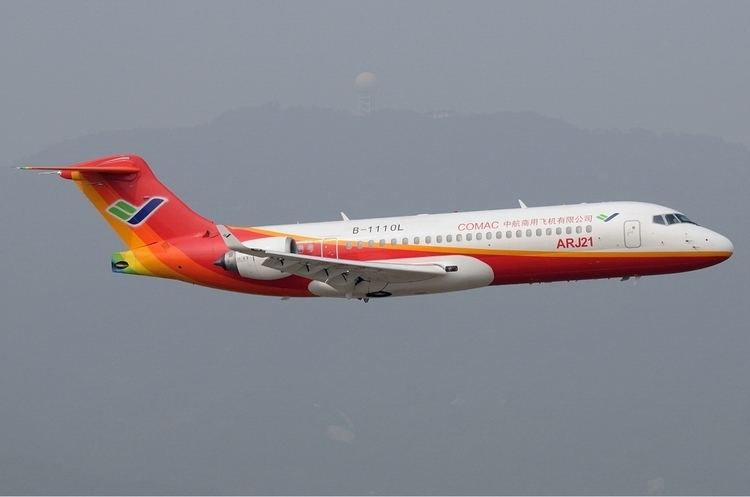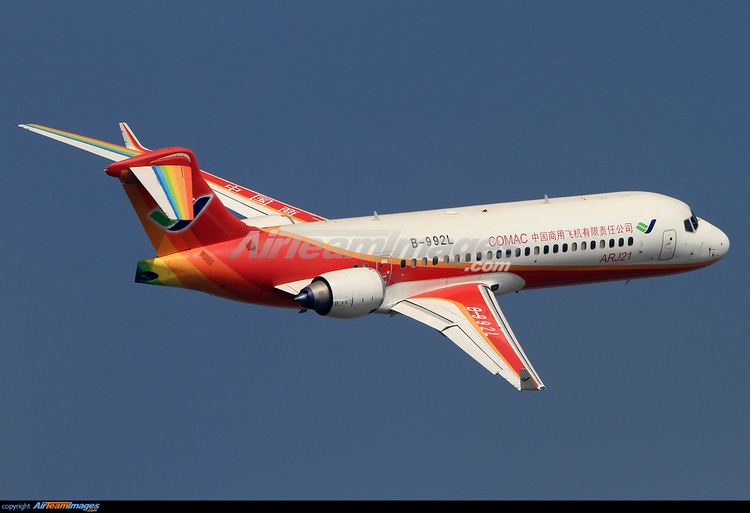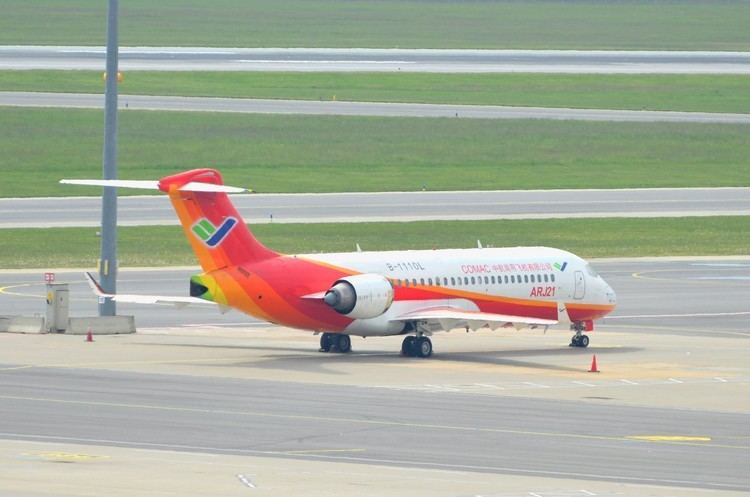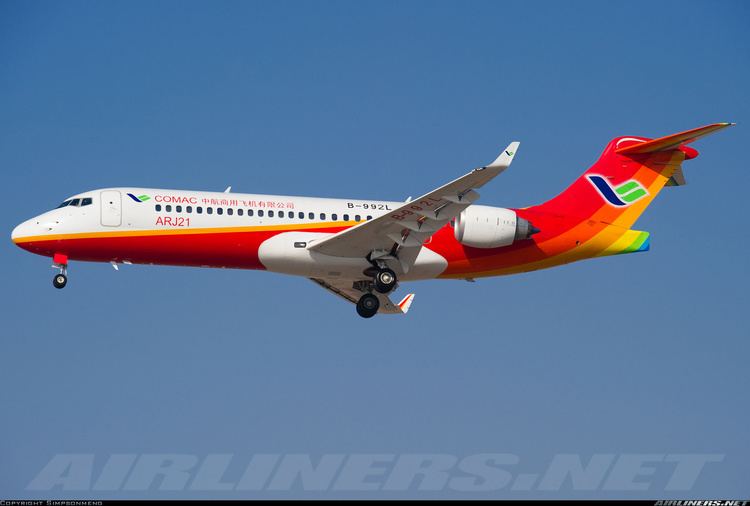Length 33 m Cruise speed 933 km/h First flight 2007 | Wingspan 27 m | |
 | ||
Unit cost 20,000,000–20,000,000 USD (2008) | ||
Comac arj21
The Comac ARJ21 Xiangfeng (Chinese: 翔凤; pinyin: xiángfèng; literally: "Flying Phoenix") is a twin-engined regional jet, manufactured by Chinese aerospace company Comac.
Contents
- Comac arj21
- Development
- Further delays and first flight
- Key flight tests and CAAC certification
- Design
- Manufacturers
- Variants
- Operators
- Orders and deliveries
- Specifications
- References

Development

The development of the ARJ21 (Advanced Regional Jet) is a key project in the "10th Five-Year Plan" of China. It began in March 2002 and was led by the state-owned ACAC consortium. The maiden flight of the ARJ21 was initially planned to take place in 2005 with commercial service beginning 18 months afterwards. The programme was to become 8 years behind schedule. The design work was delayed and the final trial production stage did not begin until June 2006. The first prototype (serial number 101) rolled out on 21 December 2007, with plans for a maiden flight in March 2008. This was first delayed to 21 September 2008 and finally took place on 28 November 2008 at Shanghai's Dachang Airfield. The aircraft completed a long distance test flight on 15 July 2009, flying from Shanghai to Xi'an in 2 hours 19 minutes, over a distance of 1,300 km. The second ARJ21 (serial number 102) completed the same test flight route on 24 August 2009. The third aircraft (serial number 103) similarly completed its first test flight on 12 September 2009. The fourth aircraft (CN 104) flew by November 2010. By August 2011, static, flutter and crosswind flight tests had been completed. Deliveries to customers were expected to begin in late 2010, starting with Chengdu Airlines.

The ACAC consortium initially aimed to manufacture 11 ARJ21s a year by 2010, and 30 per year by 2015. In 2009 the consortium was reorganized and became a part of COMAC.
Further delays and first flight

In November 2010, an ARJ21 wing failed to reach the predicted load rating during static testing. The wing's failure then led the Civil Aviation Administration of China (CAAC) to limit the aircraft’s flight envelope during its flight test program. The new delivery date was then set at the end of 2011.

On 19 August 2011, it was reported that the first delivery of the ARJ21 would likely to be delayed by up to a year or more after problems surfaced during the flight testing programme. On 24 August 2011, it was reported that two components of the testing program had not been completed; icing tests were underway but delayed, and stall speed tests had not yet begun. According to an anonymous source within the program, this could lead to delays in obtaining type certification, which could in turn lead to delays in delivery.

On 8 June 2012, a COMAC official told Reuters that ARJ21 was unlikely to get regulatory approval before 2013, without giving an official reason for the 5-year delay. A Reuters investigation suggested that problems with wing cracks, wiring and avionics had contributed to the delay.
Earning a United States Federal Aviation Administration (FAA) type certification is a precondition for the ARJ21-700 to enter the global aviation market. Since 2003, the aviation authorities of China and the USA had been negotiating the ARJ21-700 application for FAA type certification and shadow certification. As a result, the FAA will accept a type certification application of AVIC I Commercial Aircraft Company’s ARJ21-700 that will be sent by the Civil Aviation Administration of China (CAAC). The FAA also decided to develop a shadow certification for ARJ21-700 under the current standards and established the CAAC Technology Support Office in Shanghai and Beijing. At the meeting, Luo Ronghuai, assistant general manager of AVIC 1 and general manager of ACAC, said ACAC would follow the strict airworthiness standards of the CAAC and FAA.
On 28 June 2012, the ARJ21-700 travelled at high speed on a specially constructed test lane at Xi'an Yanliang airport. Since 22 June, the aircraft has undergone 10 tests on taxiing, take-off and landing at different speeds on a flooded runway. The tests ensure that the aircraft is able to taxi, take-off and land despite having water on the runway. Since the aircraft entered the validation flight test phase in February 2012, it has been scheduled to undergo 1,500 hours of validation flight tests involving 280 subjects. It has since completed the airspeed calibration, natural icing, engine nacelle anti-icing, crosswind validation tests and is preparing for a stall flight test.
In July 2012, Comac's chief financial officer Tian Min said at the Farnborough Airshow that he expected the aircraft to receive certification from both the US FAA and the Civil Aviation Administration of China in 2013, with the first delivery to launch customer Chengdu Airlines to occur around the end of 2013. He told the press that "The programme is now undergoing certification tests and flights. There have been some problems but that's part of the process and progress is good. There are no serious issues".
However, in September 2013, COMAC announced that it hoped the ARJ21-700 would achieve CAAC certification during 2014, and enter service by the end of 2014. The launch customer Chengdu Airlines was due to receive its first aircraft by the end of 2011, but ongoing delays in the certification process has caused it to be postponed. After the first production aircraft flew on 18 June 2014, it was announced that production of 2 aircraft was planned for 2014, with 5, 8, 15 and 20 aircraft in 2015, 2016, 2017 and 2018 respectively.
Key flight tests and CAAC certification
ARJ21-700 AC104 of Commercial Aircraft Corporation of China, Ltd. (COMAC) returned to China safely on April 28, 2014 after successfully completing natural icing flight testing in North America. This was the first time a turbofan-powered regional jet independently developed by China had flown abroad to carry out flight tests in special weather conditions. In the meantime, the fleet of ARJ21-700 test aircraft has achieved a global flight log of more than 30,000 km across Asia, America, Europe, and the Pacific and Atlantic oceans. This success of the ARJ21-700 in natural icing flight testing has cleared another obstacle toward airworthiness certification, and proven access and feasibility for China’s civil aircraft to carry out flight testing abroad.
ARJ21-700 AC104 successfully completed one flight of supplementary applicant flight test for compliance of airspeed calibration on October 30, 2014, which led to an entire completion of all flight tests undertaken by AC104 before Type Certification (TC).
Since the first flight on April 13, 2010, AC104 has undertaken and completed major flight tests of stall, high-speed characteristic, noise, simulated icing, minimum flight crew, etc., and has realized global flight and natural icing flight test successfully in this year. Over the years, ARJ21-700 AC104 has accumulated 711 flights in 1,442 hours and 23 minutes, and accomplished 468 test points (74 tests) of applicant flight test for compliance and 420 test points (63 tests) of certification flight test. AC104 becomes the first test aircraft which completes all the flight tests before TC.
ARJ21-700 AC105 returned to Yanliang airport at 12:32 on December 16, 2014 from Xi'an Xianyang International Airport after the last flight for function and reliability flight test, which indicates that the function and reliability flight test of ARJ21-700 aircraft has been completed successfully, and also indicates that all the flight tests before airworthiness certification of the aircraft have been completed successfully.
Function and reliability flight test is the last major special flight test before the issuance of Type Certificate (TC). ARJ21-700 aircraft has conducted the function and reliability flight test strictly in accordance with flight test plan and successfully completed the special inspection of various systems. Since the flight test was officially started on October 29, AC105 has successively conducted 83 flights in the routes among 10 airports in Chengdu, Guiyang, Guilin, Haikou, Fuzhou, Zhoushan, Tianjin, Shijiazhuang, Yinchuan and Xianyang to simulate operations in routes. The cumulative flight time was 173 hours and 55 minutes.
The ARJ21-700 advanced regional jet received its Type Certification under Chapter 25 of the Chinese civil aviation regulations from the Civil Aviation Administration of China (CAAC), on December 30, 2014.
ARJ21-700 completed the final demonstration flight on 12 September 2015 prior to delivery.
On 29 November 2015, COMAC delivered the first ARJ21-700 jet plane to Chengdu Airlines. The first commercial flight took off from Chengdu Shuangliu Airport on June 28, 2016, landing in Shanghai two hours later. one day after its commercial flight was approved by the CAAC.
During the remaining summer schedule period, i.e. until October 29, 2016, the ARJ21-700 was scheduled to operate three weekly rotations between Chengdu and Shanghai Hongqiao. Of these 108 planned flight segments, 85 were operated by ARJ21 (81 by B-3321, four by B-3322), 22 by Airbus A319 and one was cancelled. Since the beginning of the winter schedule period 2016/2017 on October 30, 2016, no flights passenger flights were scheduled nor conducted.
Design
Different sources claim the ARJ21 closely resembles either the McDonnell Douglas MD-80 or the MD-90 which were license produced in China. Chinese factories producing parts for the MD-90 went on to produce the ARJ21. China claims that the ARJ21 is a completely indigenous design. The ARJ-21's development did depend heavily on foreign suppliers, including engines and avionics from the United States.The plane features an all-new supercritical wing having a sweepback of 25 degrees and designed by Ukraine’s Antonov Design Bureau. It is fitted with winglets to improve aerodynamic performance. Antonov also assisted the project with geometrical determination and integral analysis of the construction strength of ARJ21. Some of China's supercomputers have been used to design parts for ARJ21.
Manufacturers
Members of the ACAC consortium, which was formed to develop the aircraft, will manufacture major components of the aircraft:
Variants
Operators
Two aircraft in-service with one airline as of October 2016:
Orders and deliveries
As of 2015, six ARJ21-700 have been built and one aircraft delivered to Chengdu Airlines, currently (as of 22 February 2016) performing proving runs/training flights. The actual entry-into-service (Revenue Service) date was 28 June 2016. There is a further order of 40 planes by a unnamed leasing firm during China Air Show 2016.
According to Reuters, Comac has received almost 350 orders for the ARJ-21.
Thailand City Airways ordered 10 arj-21
An Indonesia Airliners will fly with entire fleet with 60 arj-21 planes
